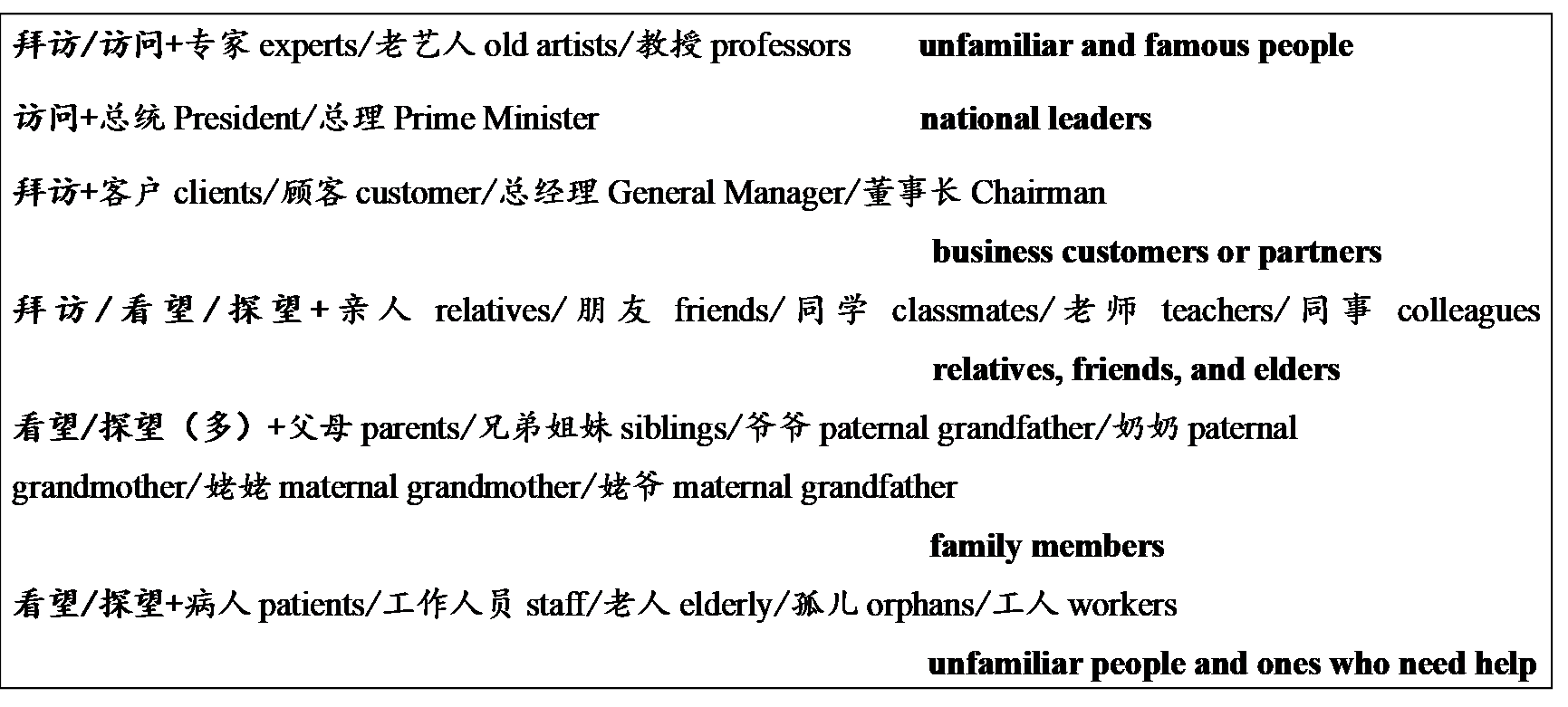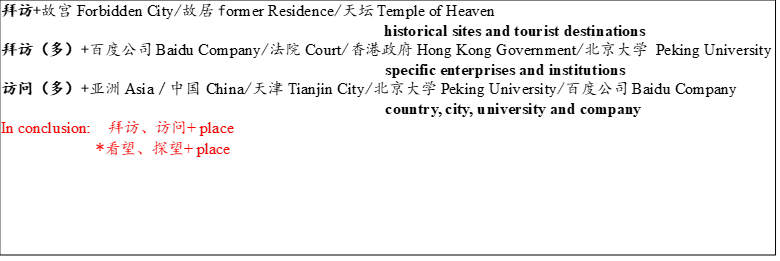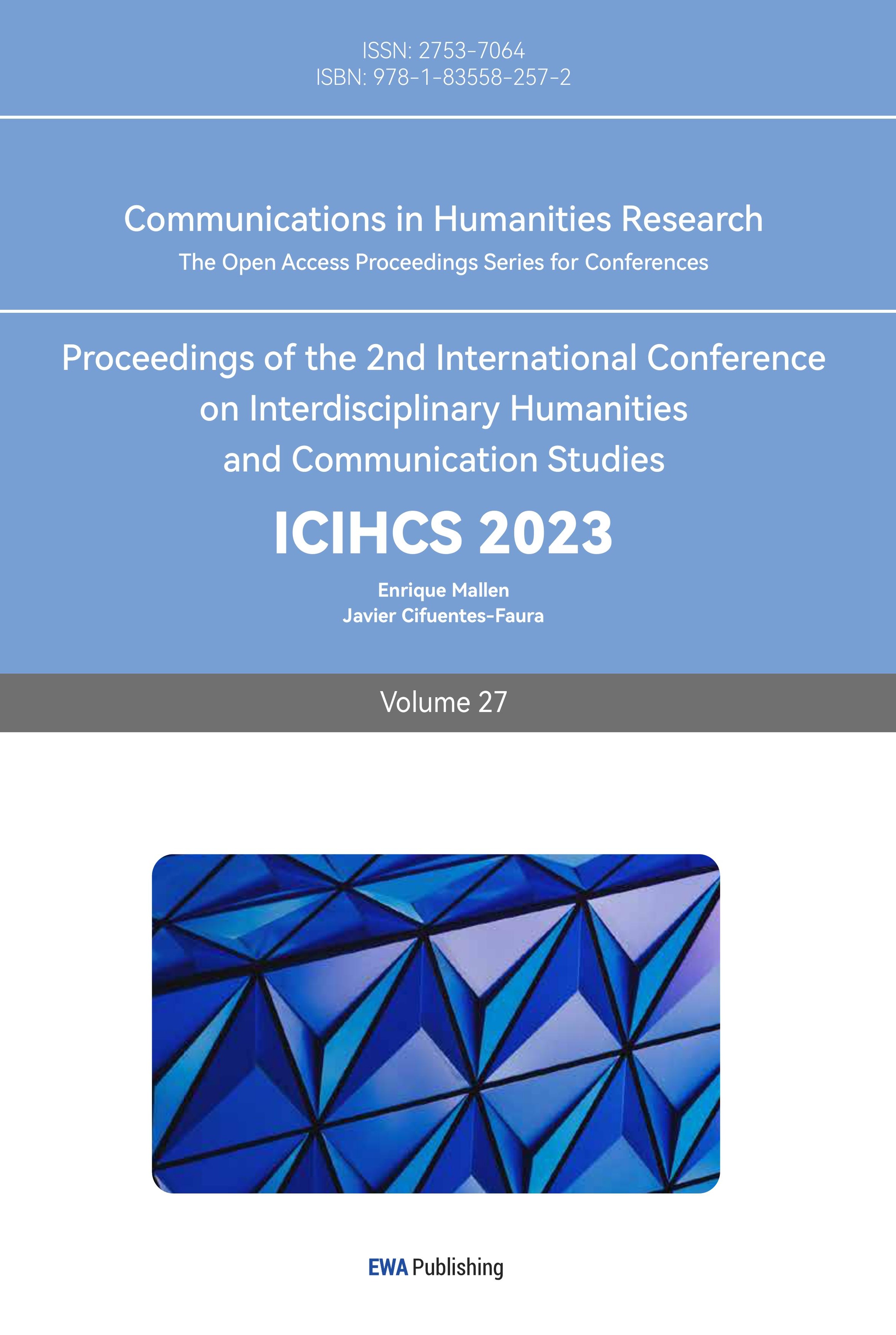1.Introduction
In the process of teaching Chinese, the author has observed frequent confusion among intermediate Chinese learners when using words related to “看望” (kànwàng - visiting) and “访问” (fǎngwèn - calling). For instance, learners often mistakenly use “探望” (tànwàng) instead of “看望” (kànwàng). Drawing on teaching experience, the author extracted errors related to these verbs from the HSK Dynamic Composition Corpus. The corpus revealed that even advanced-level Chinese learners encounter such issues, such as the misuse of “拜访” (bàifǎng - visit) with “探望,” “访问,” and “看” or the confusion between “探望” and “探,” as well as “看” and “看望.” Consulting the “Modern Chinese Dictionary,” it was found that verbs like “拜访,” “访问,” “看望,” and “探望” share the common meaning element of “seeing or visiting.” While studies on synonyms or near-synonyms often utilize the interlanguage confusion framework proposed by Zhang Bo [1], research on this specific category of synonymous verbs is limited and is often embedded within studies on visual or sensory verbs related to “看” [2], “望” [3], and other similar verb groups [4].
This paper, referencing the “International Chinese Language Education Chinese Proficiency Standards” and the “Modern Chinese Dictionary,” selects “拜访,” “访问,” “看望,” and “探望” as research subjects. Based on the Communication University of China’s Multimedia Language Corpus (MLC), this study explores their ontological distinctions from a synchronic perspective. Additionally, it analyzes their error manifestations in intermediate language corpora such as the HSK Dynamic Composition Corpus from Beijing Language University, the Written Chinese Corpus of International Students at Jinan University, and the Chinese Character Error Corpus of International Students at Sun Yat-sen University. The paper concludes with pedagogical recommendations.
Table 1: Distribution of Target Words in the “International Chinese Language Education Chinese Proficiency Standards.”
|
Serial Number |
Target Word |
“International Chinese Language Education Chinese Proficiency Standards” |
|
1 |
拜访 (bàifǎng - visit) |
Level 5 |
|
2 |
访问 (fǎngwèn - call on) |
Level 3 |
|
3 |
看望 (kànwàng - visit) |
Level 4 |
|
4 |
探望 (tànwàng - pay a visit) |
Advanced |
Table 2: Definitions of Target Words in the “Modern Chinese Dictionary”
|
Serial Number |
Target Word |
Definitions |
|
1 |
拜访 (bàifǎng - visit) |
A polite visit, paying respects, or visiting with a purpose |
|
2 |
访问 (fǎngwèn - call on) |
Purposefully going to visit, inquire, and converse with someone |
|
3 |
看望 (kànwàng - visit) |
Visiting elders, relatives, etc., to convey regards and greetings |
|
4 |
探望 (tànwàng - pay a visit) |
Visiting, especially from a distance or after a long journey |
2.Ontological Study of Confusable Words in the “看望” and “访问” Category
2.1.Semantic Features
Lyons proposed four semantic relationships existing within a semantic field: inclusion, overlap, complementarity, and proximity [4]. Semantic overlap results in the formation of synonyms. Words like “看望” (kànwàng - visit) and “访问” (fǎngwèn - call on) share a specific semantic field, indicating an overlap in semantic relationships. These words are used in written language, characterized by a strong purpose, conveying the respect of the subject toward a specific object. The agent of the action often visits a particular place with a specific purpose, inquiring about or discussing specific content. These words exhibit behaviors such as [+meeting], [+conversation], [+inquiry], and [+visiting], with both the subject and object possessing the feature of [+human]. There are differences in semantic emphasis, including variations in the subject and object, duration of action, and location.
Table 3: Differences and Similarities in Target Words in Terms of Subject and Object, Behavioral Characteristics, and Duration of Action
|
Semantic Components |
Subject |
Behavior |
Object |
Duration |
||||||
|
Human |
Meeting |
Talking |
Inquiring |
Visiting |
Interviewing (Person) |
Visiting (Place) |
Human |
Place |
Long |
|
|
拜访 (bàifǎng - visit) |
± |
+ |
+ |
+ |
+ |
± |
± |
± |
+ |
- |
|
访问 (fǎngwèn - call on) |
+ |
+ |
+ |
+ |
+ |
± |
± |
+ |
+ |
+ |
|
看望 (kànwàng - visit) |
+ |
+ |
+ |
+ |
+ |
- |
- |
± |
- |
- |
|
探望 (tànwàng - pay a visit) |
+ |
+ |
+ |
+ |
+ |
- |
- |
+ |
- |
- |
2.1.1.Subject, Object, and Behavior
The subject of “拜访” can be [-human], as in “小昆虫拜访办公室” (Little insects visiting the office). Both “拜访” and “看望” can have a non-human object [-human], as in “到南极拜访企鹅” (Visit penguins in Antarctica) and “看望被救助的小猫” (Visit the rescued little cat). The objects of “拜访” and “访问” can be [+location], and the actions can be {±采访[+person]} (±interview[+person]) and {±参观[+location]} (±visit[+location]), as in “到平溪老街拜访” (Visit Pingxi Old Street), “对亚洲进行访问” (Visit Asia), and “感谢接受节目的拜访” (Thank you for accepting the program’s visit).
“访问” is less likely to have friends and relatives as objects, as seen in “访问了2500户人家” (Visited 2500 households). The objects of “拜访,” “看望,” and “探望” can be familiar friends, family members, and teachers, as in “看望父母” (Visit parents), “拜访未来的岳父岳母” (Visit future parents-in-law), “拜访朋友” (Visit friends), and “探望子女” (Visit children). “拜访” is less likely to have younger generations as objects.
The objects of “拜访” can also include customers, voters, and party members, as in “拜访民进党主席” (Visit the chairperson of the Democratic Progressive Party).
The objects of “看望” and “探望” can be vulnerable groups such as the elderly, weak, sick, lower-level workers, orphans, and those facing difficulties and disasters, as in “看望困难群众” (Visit disadvantaged groups) and “探望孤寡老人” (Visit lonely elderly).
2.1.2.Location of Action and Duration
The actions of “拜访” and “访问” often take place in countries, cities, schools, companies, and organizations. For example, “访问日本、蒙古、缅甸三国” (Visit Japan, Mongolia, and Myanmar), “访问了庞巴迪集团总部” (Visited the headquarters of Bombardier Group), and “访问了南开大学” (Visited Nankai University).
The actions of “看望” and “探望” typically occur in places like hospitals, nursing homes, welfare centers, meeting venues, disaster areas, etc. For instance, “到成都华西医院重症病房探望伤员” (Visited the critically ill patients in the intensive care unit of West China Hospital in Chengdu), “探望敬老院的孤寡老人” (Visited the lonely elderly in the nursing home), “去福利中心探望小粤粤” (Visited Xiaoyueyue at the welfare center), “看望出席会议的科协、科技界委员” (Visited and extended condolences to the members of the Science and Technology Association attending the conference), and “看望慰问地震灾区干部群众” (Visited and offered condolences to officials and residents in the earthquake-stricken areas).
The action of “探望” can also take place in places where rights are restricted, such as in public security, judicial institutions, or other countries (regions). For example, “探望我国被扣船长和船员” (Visited the detained captain and crew of our country).
When the object’s location is a country, activities of “拜访” and “访问” are generally diplomatic. “访问” has a higher frequency and longer duration, as seen in “对中国进行为期5天的国事访问” (Conducting a 5-day state visit to China) and “这次访问历时72天” (This visit lasted for 72 days).
2.2.Grammatical Features
“看望” and “访问” exhibit similar syntactic functions, primarily functioning as predicate components in sentences. They often appear in compound sentences and double-object sentences. Time adverbs, modal adverbs, and location adverbs preceding them are commonly used, and dynamic particles “了” and “过,” as well as dynamic complements like “次” and “一下,” may follow. Grammatical differences mainly manifest in part of speech, collocations when serving as predicates, and functioning as other sentence components (modifiers, objects).
2.2.1.Part of Speech Differences and Similarities
Table 4: Differences and Similarities of Target Words as Nouns
|
Target Words |
拜访 (bàifǎng - visit) |
访问 (fǎngwèn - call on) |
看望 (kànwàng - visit) |
探望 (tànwàng - pay a visit) |
|
Quantifier |
次 (cì - times) |
次/个 (often used) |
||
|
Denotes Type or Nature in Determinative Structure |
官事/高层 (official/business or high-level) |
国事/友好/正式/工作/会议/私人 (state affairs, friendship, formal, work, meeting, personal) |
||
|
Denotes Time in Determinative Structure |
为期……天的/短暂的/闪电/旋风式 (lasting...days, brief, swift, whirlwind-style) |
|||
|
Verbal Phrases Indicating Activity Progression |
开始/展开/进行/结束/推迟/取消/中断 (start, unfold, conduct, end, postpone, cancel, interrupt) |
|||
|
Expresses Interview Meaning |
“感谢您接受我们节目的拜访” (“Thank you for accepting our program’s visit”) |
“感谢您接受我们节目的访问” (“Thank you for accepting our program’s visit”) |
Both “拜访” (bàifǎng - visit) and “访问” (fǎngwèn - call on) appear as nouns in the corpus and can be modified by the quantifier “次” (cì - times). The instances of “访问” as a noun far exceed those of “拜访,” and it is more frequently paired with the quantifier “次” than “个” (gè). “访问” can be extensively modified by words indicating types and nature, and it can be further modified by expressions like “为期……天的” (lasting...days) and “短暂” (brief), indicating the duration of the activity. As a noun, “访问” can function as the object of verbs expressing activity progression, such as “开始” (start), “展开” (unfold), “进行” (conduct), “结束” (end), “推迟” (postpone), “取消” (cancel), and “中断” (interrupt). On the other hand, “拜访” is primarily modified by “官事” (official/business) and “High层” (high-level).
2.2.2.Predicate Collocations
Table 5: Differences and Similarities in Predicate Collocations of Target Words
|
Tendency verbs |
Preceding with Locative Phrase |
Preceding with Bisyllabic Verbs |
Target Words |
Following with Bisyllabic Verbs |
|
+ |
登门、上门等 (visit, come over, etc.) |
- |
拜访 (visit) |
- |
|
Often |
- |
参观(多)、考察、观光 (visit (often), inspect, sightsee) |
访问 (call on) |
交流、演出 (communicate, perform) |
|
Less Often |
回家、登门等 (return home, visit, etc.) |
走访(少) (visit (less often)) |
看望 (visit) |
慰问(多)、照顾、安慰等 (console (often), take care, comfort, etc.) |
|
+ |
回家、登门、入户等 (return home, visit, enter the household, etc.) |
- |
探望 (visit) |
慰问(多)、照顾、帮助等 (console (often), take care, help, etc.) |
Tendency verbs frequently appear before words of the “看望、访问” class, with the highest frequency of conjunction observed with “看望” and the least with “访问.” Verb phrases indicating locations such as “出门、登门、上门、北上、回家,” primarily associated with movements to specific places, are used before “看望、拜访、探望” but less frequently with “访问.” Bisyllabic verbs like “慰问、照顾” often co-occur with “看望、探望” and are employed when leaders console and care for the grassroots. The most common bisyllabic verb in conjunction with “访问” is “参观,” occurring before “访问” more frequently. Instances of bisyllabic verbs co-occurring with “拜访” are infrequent in the corpus.
2.2.3.Differences and Similarities in Adverbial Phrases
Figure 1: Order of Multiple Adverbial Phrases before Target Words
Note: The order of multiple adverbial phrases before “看望、访问” does not include adverbial phrases expressing negation, frequency, range, etc.
Descriptive adverbial phrases [5] often appear between the subject and the target words, while adverbial phrases describing the doer of the action are infrequent in the corpus. Adverbial phrases describing the action are frequently quantity phrases like “……次” (… times) and modal adverbs, with high occurrences of modal adverbs such as “亲自、亲切、分别、专程、专门” (personally, cordially, separately, specifically, specially).
Among non-descriptive adverbial phrases, locative adverbs, cooperative adverbs, conditional adverbs, and temporal adverbs have fixed positions in sentences, while adverbs expressing negation, frequency, and range can appear in different positions. Temporal adverbs have the highest frequency, followed by frequency and locative adverbs. Adverbs related to involvement, range, possibility, and negation are less common.
In sentences with “拜访、看望、探望,” temporal adverbs often follow the sequence “time word—prepositional phrase—temporal adverb.” However, in sentences with “访问,” the sequence for temporal adverbs is “temporal adverb—prepositional phrase,” where prepositional phrases often include “于……” (on/at) paired with specific time words.
2.2.4.Differences and Similarities in Serving as Other Sentence Elements
Table 6: Differences and Similarities in Target Words Serving as Other Sentence Elements
|
Target Word |
拜访 (bàifǎng) |
访问 (fǎngwèn) |
看望 (kànwàng) |
探望 (tànwàng) |
|
|
Attributive |
Target word + 的 |
+ |
+ |
+ |
+ |
|
Directly modifies the head noun |
~ 活动、~ 之旅 (少) ~event,~journey(few) |
~ 学者、~ 签证、~ 人数、~ 团 (多) ~ scholar,~ visa, numbers of~,~group(many) |
~ 活动 (少) ~event(few) |
~ 权 (多), ~ 人, ~ 地点, ~ 要求 ~right(many),~people,~location,~requirement |
|
|
Object |
Combined with other elements |
进行~(少) carry out ~ (few) |
进行~(多) 对~ 表示欢迎carry out ~ (many), Welcome ~ to... |
进行~ (少)carry out ~ (few) |
进行~(少) carry out ~ (few) |
|
Adverbial |
Combined with other elements |
+ |
+ (most during ...~) |
+ |
+ |
|
Subject |
Combined with other elements |
+ |
+ |
+ |
+ |
In sentence structures, “拜访 (bàifǎng),” “访问 (fǎngwèn),” “看望 (kànwàng),” and “探望 (tànwàng)” can function as attributive, object, adverbial, and subject. When used as attributives, these four words can appear before the possessive particle “的” or directly modify the head noun. Notably, “访问” often directly modifies the head noun. As objects, “访问” is frequently used and commonly serves as the object of the verb “进行 (carry out).”
2.3.Pragmatic Features
Drawing on the nature of activities related to “拜访、访问、看望、探望,” considering the roles, professions, and communicative intentions of the actors [6], the author categorizes these activities into commercial, political diplomatic, cultural educational, daily interaction, legal, holiday greetings, and public welfare. The frequency of use is denoted as “high” or “low” to distinguish their pragmatic features.
Table 7: Differentiating the Use of Target Words
|
Nature of Activities |
拜访 (bàifǎng) |
访问 (fǎngwèn) |
看望 (kànwàng) |
探望 (tànwàng) |
|
Commercial |
High |
Visit and exchange among peers |
Low |
Low |
|
Political Diplomacy |
Between countries; Between domestic governments; Government visits to grassroots level; Party disputes |
Between countries; Between domestic governments |
Government visits to grassroots level |
Government visits to grassroots level |
|
Cultural Education |
Media program interviews; School education cooperation (Low) |
Media program interviews; School education cooperation (High) |
Low |
Low |
|
Daily Interaction Legal Holiday Greetings |
High |
Low |
High |
High |
|
Can be used for couples, unmarried couples, married couples greeting each other’s parents |
Low |
Both applicable |
Both applicable |
|
|
Less used for family members |
||||
|
Public Welfare |
Low |
Law enforcement personnel have the right to visit and investigate cases |
Low |
One divorced parent has the right to visit children; Relatives, friends, and defendant’s representatives have the right to visit the defendant |
|
Commercial |
Low |
Low |
Leaders visit grassroots personnel |
Leaders visit grassroots personnel |
|
Political Diplomacy |
Low |
Low |
Help vulnerable groups |
Help vulnerable groups |
Commercial activities often use “拜访”; in political diplomacy activities, “看望” and “探望” are often used for government leaders’ activities with grassroots or frontline workers, while “拜访” is often used for national diplomacy and party competition activities, and “访问” is mainly used for national diplomatic activities; in cultural and educational activities, “拜访” and “访问” are often used for media interviews and school education cooperation activities; in daily interaction activities, “访问” is less used for interactions with friends and relatives; in legal activities, “访问” is often used for police investigations, and “探望” is often used in situations where the rights of the person or the location are restricted; in holiday greetings activities, “看望” and “探望” are often used for leaders visiting grassroots personnel in enterprises and institutions; “看望” and “探望” are often used in public welfare activities that focus on vulnerable groups.
3.Study on the Confused Use of “看望” and “访问”
Confused words are composed of misused words and correctly used words [7]. Starting from the inter-lexical relationship and misuse relationship between misused words and correctly used words, searching through the interlanguage corpus, it is found that the confusion between “看望” and “访问” is concentrated in misuse, with both one-to-one and one-to-many inter-lexical confusion relationships. The misuse is mainly unidirectional, and students are prone to confusion in semantics and pragmatics.
3.1.Inter-Lexical Relationship between Misused Words and Correctly Used Words
3.1.1.One-to-One Confusion
One-to-one confusion refers to a situation where there is only one correctly used word corresponding to a misused word. In the error sentences, the misused word “访问” corresponds to only one correctly used word, for example:
(1) 我的表姐和朋友住在美国,所以我访问他们的家。(My cousin and friends live in the United States, so I visited their home.)
(2) 另外访问亲戚、朋友家。(Visit relatives and friends' homes.)
In the above examples, “访问” should be replaced with “拜访.” Both (1) and (2) express visiting friends and relatives’ homes, and “拜访” is more appropriate for this usage. While “看望” and “探望” mainly refer to interpersonal activities among relatives and friends, the object is generally a person, not a location. Although “访问” can take a location as an object, it is less common for interactions between friends and relatives, mainly used for formal activities. Therefore, in the above examples, we should use “拜访.”
3.1.2.One-to-Many Confusion
One-to-many confusion refers to a situation where there are multiple correctly used words corresponding to a misused word. In the error sentences, the misused word “拜访” corresponds to two correctly used words—”看望” and “探望,” which is a one-to-many confusion.
(a) 拜访-看望
(3) 我的母亲也有来拜访父亲。(My mother also came to visit my father.)
(4) 我想请假27天拜访父母,希望领导批准。(I would like to ask for a leave of 27 days to visit my parents, and I hope the leader can approve it.)
In the above examples, the relationship between the subject and the object is relatively intimate. In (3), it is a spousal relationship, and in (4), it is a relationship between children and parents. These situations involve family members, and when interacting with family, the term “看望” (visit) is more commonly used than the more formal and respectful “拜访” (visit).
(b) 拜访-探望
(5) 我很想爸妈,明年中秋节我一定回国要拜访他们。(I miss my parents very much. I will come back to visit them next Mid-Autumn Festival.)
In this example, the term “拜访” (visit) appears in the HSK dynamic essay corpus. The corpus considers the appropriate term for this context to be “探望” (visit), although “看望” (visit) can also be used for holiday greetings between children and parents, and the spatial distance between the subject and the object can be either near or far. In this case, “看望” (visit) is also appropriate.
3.2.Direction of Confused Word Misuse
In terms of the direction of misuse, confused words can be classified into unidirectional misuse and bidirectional misuse. Unidirectional misuse means that students misuse word A as word B, but do not make the reverse mistake. Bidirectional misuse is the opposite; students may misuse either word A as word B or word B as word A.
In the error corpus, we find that “拜访” and “看望” belong to unidirectional misuse, and “访问” and “拜访” also fall into this category.
4.Teaching Strategies
4.1.Morpheme Teaching
For terms with common morphemes such as “拜访” (visit) and “访问” (visit), “看望” (visit), and “探望” (visit), teachers can adopt morphemic analysis. The easily confused terms “看望” (visit) and “探望” (visit) share the morpheme “望” (to look), where “望” has the fundamental meaning of looking into the distance. Both terms involve distant visits to greet someone, inquire about their daily life and health. The distinction lies in the morphemes “看” (to look) and “探” (to explore). “看” (to look) can refer to both near and far observations, while “探” (to explore) implies discovering conditions hidden in depth, indicating a deeper spatial distance. Therefore, for regular interactions with close friends and family in proximity, “看望” (visit) is more commonly used.
For word groups without shared morphemes but with common semantic elements, teachers can employ semantic analysis. For instance, “拜访” (visit) and “看望” (visit) lack common morphemes but share the semantic element “看望” (visit), suitable for greetings between close friends and family. When greeting the parents of a romantic partner, unmarried or married couples often use “拜访” (visit), while interactions within the family typically involve “看望” (visit), with “拜访” (visit) less commonly used for younger generations..
4.2.Emphasize Word Collocation
Based on the principles of high usage frequency and relevance to daily life, teachers can provide word lists for expressions like “去某地看望某人” (go to a place to visit someone) and guide students in summarizing the semantic features of the objects in these expressions. For example:

Figure 2: Teaching Design for Word Collocations 1

Figure 3: Teaching Design for Word Collocations 2
4.3.Contextual Teaching
Based on the functions of words and common contexts, provide situational examples for students to consolidate their practice, such as:

Figure 4: Target Word Discrimination Teaching Design
“访问” is mostly used in diplomatic situations involving exchanges and learning between countries, governments, and organizations, as seen in (1) and (11). It can also be used for interviews with celebrities, as shown in (10) and (12). “拜访” can be used for visiting scenic spots, as in (2), and is commonly used in business dealings, as seen in (3) and (5). It can also be used for interview activities, as in (10) and (12). “看望” can be used both near and far, as in the close visit in (3) and the distant one in (4). “看望” and “探望” can be used for public welfare activities, as in (8), and for holiday greetings, as in (9). “探望” can also be used in legal contexts, as seen in (6) and (7).
5.Conclusion
Through the analysis of native speakers and interlanguage corpora, a large amount of authentic language data was used to comprehensively explore the specialized study of easily confused words in the “看望、访问” category. These words overlap in semantics, grammar, and pragmatics, requiring differentiation based on semantic distinguishing features, parts of speech, collocations, roles in sentences, nature of activities, etc. Understanding the ontology of the research, considering common confusion situations among students, and designing more targeted and flexible textbooks and learning dictionaries are necessary. It is also important to explore the different expressions of such words in different languages and deepen the research in language teaching.



